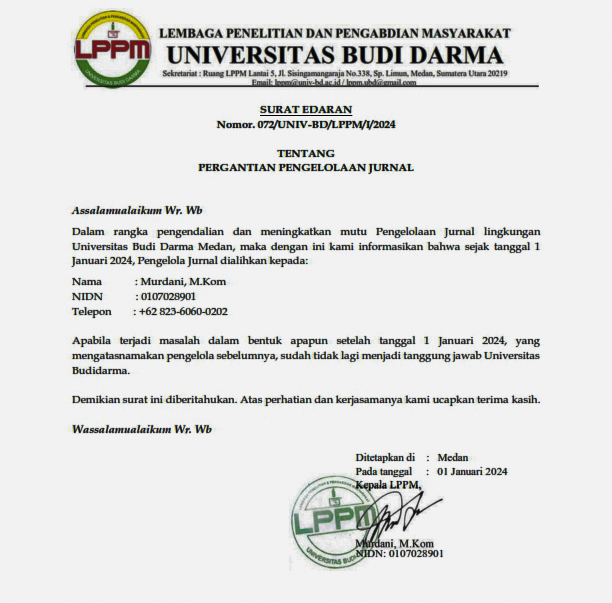Studi Kinerja Jaringan LoRa: Optimalisasi dan Analisis Efisiensi Komunikasi Nirkabel
DOI:
https://doi.org/10.30865/json.v5i2.7147Keywords:
LoRa, IoT, Frekuensi, Line of Sight, Non-Line of SightAbstract
LoRa is a long-range wireless connectivity technology, considered an innovative solution for implementing the Internet of Things (IoT). This research encompasses a series of performance tests conducted under various conditions, including Line of Sight (open) and Non-Line of Sight (closed), utilizing the ISM 915 MHz frequency. The importance of testing optimization and efficiency analysis of LoRa is a key factor in ensuring the optimal performance and sustainability of this technology. The testing process involves several stages. The first test assesses the communication range of LoRa SX1276 within a building, determining its communication capabilities indoors. The second test focuses on the maximum communication range, identifying the farthest distance at which LoRa SX1276 can maintain a stable and reliable connection. The third test evaluates the performance of data transmission in a closed environment, specifically Non-Line of Sight conditions, to assess how well LoRa SX1276 maintains data transmission performance in situations with obstacles or hindrances. The fourth test assesses the resilience of LoRa SX1276 in long-term operations, evaluating the network's durability and reliability over an extended period. The fifth test conducts a comprehensive analysis of the system's performance, including aspects such as delay, data delivery, and data loss. This research aims to provide a deeper understanding of the capabilities of LoRa SX1276 in various usage scenarios. The results are expected to contribute to the development and implementation of LoRa SX1276 technology in diverse applications requiring wireless connectivity with extensive range and high efficiency.References
A. Augustin, J. Yi, T. Clausen, and W. Townsley, “A Study of LoRa: Long Range & Low Power Networks for the Internet of Things,†Sensors, vol. 16, no. 9, p. 1466, Sep. 2016, doi: 10.3390/s16091466.
A. Sharma, D. Singh Kapoor, A. Nayyar, B. Qureshi, K. Jot Singh, and K. Thakur, “Exploration of IoT Nodes Communication Using LoRaWAN in Forest Environment,†Computers, Materials & Continua, vol. 71, no. 3, pp. 6239–6256, 2022, doi: 10.32604/cmc.2022.024639.
J. Petäjäjärvi, K. Mikhaylov, M. Pettissalo, J. Janhunen, and J. Iinatti, “Performance of a low-power wide-area network based on lora technology: Doppler robustness, scalability, and coverage,†Int J Distrib Sens Netw, vol. 13, no. 3, Mar. 2017, doi: 10.1177/1550147717699412.
E. Murdyantoro, A. W. W. Nugraha, A. W. Wardhana, A. Fadli, and M. I. Zulfa, “A review of LoRa technology and its potential use for rural development in Indonesia,†2019, p. 020011. doi: 10.1063/1.5097480.
Y. Li, J. Yang, and J. Wang, “DyLoRa: Towards Energy Efficient Dynamic LoRa Transmission Control,†2020.
V. Križanović, K. Grgić, J. Spišić, and D. Žagar, “An Advanced Energy-Efficient Environmental Monitoring in Precision Agriculture Using Lora-Based Wireless Sensor Net-works,†2023, doi: 10.20944/preprints202306.1057.v1.
L. Y. Astutik and R. Yusuf, “Performance Study of LoRa IoT Technology,†in 2022 12th International Conference on System Engineering and Technology (ICSET), IEEE, Oct. 2022, pp. 31–35. doi: 10.1109/ICSET57543.2022.10011110.
A. R. Zain, S. Azka, R. Hudi, and I. Neforawati, “Analisis Pengiriman Data Dari Gateway LoRa ke,†2021.
H. Zhong, L. Ning, J. Wang, S. Suo, and L. Chen, “Optimization of LoRa SF Allocation Based on Deep Reinforcement Learning,†Wirel Commun Mob Comput, vol. 2022, 2022, doi: 10.1155/2022/1690667.
G. Callebaut, G. Ottoy, and L. Van Der Perre, Cross-Layer Framework and Optimization for Efficient Use of the Energy Budget of IoT Nodes. [Online]. Available: https://github.com/thethingsnetwork (accessed Dec. 01, 2023).
L. GarcÃa, J. M. Jimenez, J. Lloret, and P. Lorenz, “WiFi and LoRa Energy Consumption Comparison in IoT ESP 32/ SX1278 Devices.†[Online]. Available: http://hdl.handle.net/10251/180545http://hdl.handle.net/10251/180545https: //www.iaria.org/conferences2019/SMART19.html (accessed Dec. 01, 2023).
M. Bor, U. Roedig, T. Voigt, and J. M. Alonso, “Do LoRa low-power wide-area networks scale?,†in MSWiM 2016 - Proceedings of the 19th ACM International Conference on Modeling, Analysis and Simulation of Wireless and Mobile Systems, Association for Computing Machinery, Inc, Nov. 2016, pp. 59–67. doi: 10.1145/2988287.2989163.
D. Sallyna, U. Kurniawan Usman, and M. A. Murti, “PERENCANAAN JARINGAN LONG RANGE (LORA) PADA FREKUENSI 920 MHz-923 MHz DI KOTA BANDUNG LONG RANGE (LORA) NETWORK PLANNING WITH FREQUENCY 920 MHz-923 MHz IN BANDUNG CITY,†vol. 7, no. 1, 2020.
E. F. Silva et al., “Adaptive Parameters for LoRa-Based Networks Physical-Layer,†Sensors, vol. 23, no. 10, p. 4597, May 2023, doi: 10.3390/s23104597.
Y. Yazid, A. Guerrero-González, I. Ez-Zazi, A. El Oualkadi, and M. Arioua, “A Reinforcement Learning Based Transmission Parameter Selection and Energy Management for Long Range Internet of Things,†Sensors, vol. 22, no. 15, p. 5662, Jul. 2022, doi: 10.3390/s22155662.
A. Djoudi, R. Zitouni, N. Zangar, and L. George, Genetic Algorithm For LoRa Transmission Parameter Selection. [Online]. Available: https://lora-alliance.org/resource-hub/lorawanr-specification- (accessed Dec. 03, 2023).
“An evaluation of LoRa transmission parameter selection for indoor positioning,†2022.
M. Bor and U. Roedig, “LoRa Transmission Parameter Selection,†in 2017 13th International Conference on Distributed Computing in Sensor Systems (DCOSS), IEEE, Jun. 2017, pp. 27–34. doi: 10.1109/DCOSS.2017.10.
K.-H. Ke et al., “Demo Abstract: A LoRa Wireless Mesh Networking Module for Campus-Scale Monitoring.†[Online]. Available: https://www.lora-alliance.org/ (accessed Dec. 03, 2023).
Institute of Electrical and Electronics Engineers Indonesia Section, 2022 International Conference on Information Technology Research and Innovation (ICITRI) virtual conference, November 10, 2022$d.
R. Sanchez-Iborra, J. Sanchez-Gomez, J. Ballesta-Viñas, M.-D. Cano, and A. Skarmeta, “Performance Evaluation of LoRa Considering Scenario Conditions,†Sensors, vol. 18, no. 3, p. 772, Mar. 2018, doi: 10.3390/s18030772.
Downloads
Published
How to Cite
Issue
Section
License

This work is licensed under a Creative Commons Attribution 4.0 International License
Authors who publish with this journal agree to the following terms:
- Authors retain copyright and grant the journal right of first publication with the work simultaneously licensed under Creative Commons Attribution 4.0 International License that allows others to share the work with an acknowledgment of the work's authorship and initial publication in this journal.
- Authors are able to enter into separate, additional contractual arrangements for the non-exclusive distribution of the journal's published version of the work (e.g., post it to an institutional repository or publish it in a book), with an acknowledgment of its initial publication in this journal.
- Authors are permitted and encouraged to post their work online (e.g., in institutional repositories or on their website) prior to and during the submission process, as it can lead to productive exchanges, as well as earlier and greater citation of published work (Refer to The Effect of Open Access).





